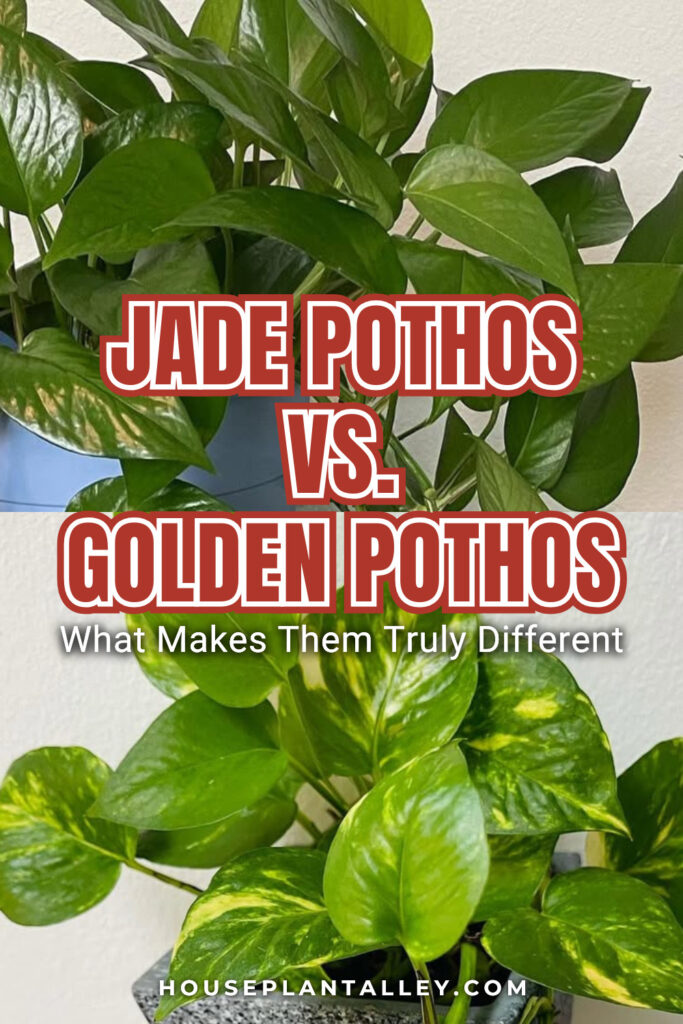Two green champions enter the ring, but only one will claim the crown in your living room. Jade and Golden Pothos might share the same scientific lineage—both descendants of Epipremnum aureum—yet they couldn’t be more different in their visual appeal and growing preferences. One thrives in shadowy corners with solid emerald leaves, while the other demands brighter spots to showcase its signature golden variegation. The question isn’t which one’s better, but which one matches your space.

Contents
- 1 Meet the Contenders: Botanical Background and Taxonomy
- 2 From French Polynesia to Your Home: Origins and Natural Habitat
- 3 Spotting the Differences: Leaf Color and Physical Characteristics
- 4 Growth Patterns and Speed Comparison
- 5 Light Requirements: Finding the Sweet Spot for Each Variety
- 6 Watering, Soil, and Environmental Needs
- 7 Temperature and Humidity Preferences
- 8 Feeding Your Plants: Fertilizer Guidelines for Optimal Growth
Meet the Contenders: Botanical Background and Taxonomy
Before diving into care differences, it’s essential to understand that Jade and Golden Pothos share identical botanical roots. Both varieties belong to Epipremnum aureum, making them the same species with different cultivar characteristics. Golden Pothos represents the original species, while Jade Pothos is the ‘Jade’ cultivar of this plant. Their botanical classification places them in the Arum family, Araceae, alongside other popular houseplants. The epithet ‘aureum’ means gold, referencing the original Golden variety’s signature coloring. This shared DNA explains why their care requirements remain virtually identical, despite their visual differences.
From French Polynesia to Your Home: Origins and Natural Habitat

While these beloved houseplants now grace windowsills worldwide, both Jade and Golden Pothos originally called the remote islands of French Polynesia home. These tropical vines naturally climb tree trunks or sprawl as ground cover across forest floors, developing larger leaves and even flowering under ideal conditions—something they rarely do indoors.
Their journey from remote Pacific islands to global houseplant status carries significant cultural significance, transforming from wild forest dwellers to cherished indoor companions. However, their widespread cultivation has created ecological impact in regions where they’ve naturalized, spreading across Asia, Australia, and South Africa’s subtropical forests.
Spotting the Differences: Leaf Color and Physical Characteristics
The most reliable way to distinguish between these two popular cultivars lies in their leaf coloration, though the differences can be subtle at first glance. Jade Pothos maintains solid green leaves year-round, while Golden Pothos displays distinctive gold flecks and variegation that shifts with lighting conditions. The leaf texture remains consistent between both varieties, featuring that characteristic waxy feel and heart-shaped form.
Color variations become more pronounced under bright, indirect light. Golden Pothos develops vibrant yellow streaks, but these fade in darker spaces. Jade leaves stay uniformly green regardless of light exposure, making them easier to identify in low-light environments.
Growth Patterns and Speed Comparison
Both varieties reach impressive lengths of up to 10 feet at maturity, but they don’t grow at identical speeds. Golden Pothos grows 12-18 inches per month during spring and summer, while Jade Pothos edges ahead slightly at 15-18 inches monthly growth. The difference comes down to variegation—Jade’s solid green leaves contain more chlorophyll, giving it a growth advantage.
Their growth habits remain remarkably similar otherwise. Both varieties thrive as trailing vines or climbing plants, developing the same heart-shaped leaves and waxy texture. Ideal care conditions will maximize growth rates for both, making either choice rewarding for plant enthusiasts.
Light Requirements: Finding the Sweet Spot for Each Variety
Although bright, indirect light creates ideal conditions for both varieties, Jade and Golden Pothos have distinctly different tolerances that affect their placement in your home. Jade Pothos excels in lower light intensity situations, making it perfect for darker corners or rooms with minimal natural light. Its superior shadow tolerance means it’ll maintain healthy growth even in challenging spots. Golden Pothos, however, needs more consistent bright light to preserve its signature golden flecks and variegation. Without adequate light intensity, those beautiful gold markings fade, and the plant fundamentally transforms into solid green leaves, losing its distinctive character completely.
Watering, Soil, and Environmental Needs
Once you’ve mastered their lighting preferences, proper watering becomes your next priority for keeping these green beauties thriving. Both varieties share identical watering techniques—let the top 1-2 inches of soil dry between waterings. Test with your finger or a wooden skewer to check moisture levels.
Soil composition matters tremendously for preventing root rot. Regular potting soil retains too much moisture, so create a well-draining mix using potting soil, perlite, and coconut coir. This combination provides proper drainage while retaining necessary moisture.
Temperature-wise, maintain 65°F to 85°F, and aim for 60-70% humidity for ideal growth conditions.
Temperature and Humidity Preferences
While soil and watering form the foundation of Pothos care, temperature and humidity create the environmental conditions that determine whether your plants simply survive or truly flourish. Both Jade and Golden varieties thrive in temperatures between 65°F to 85°F, with growth stopping below 60°F and serious damage occurring below 50°F.
Temperature fluctuations, especially cold drafts during winter, can stress these tropical plants considerably. Humidity levels should ideally reach 60% to 70%, though both varieties adapt to levels above 40%. Low humidity causes brown, crispy leaf edges, making humidifiers valuable for peak growth.
Feeding Your Plants: Fertilizer Guidelines for Optimal Growth
Since both Jade and Golden Pothos deplete their soil’s nutrients within a few months after purchase, monthly fertilizing during spring and summer becomes essential for maintaining vigorous growth. Both varieties respond well to balanced liquid fertilizers or slow-release options applied seasonally.
Effective feeding schedules involve diluting liquid fertilizer to half strength, preventing leaf drop from overfertilization. Different fertilizer types work equally well—water-soluble formulas offer precise control, while granular slow-release options provide steady nutrition. Follow package instructions carefully, as thriving plants often need less than recommended amounts. Skip winter feeding when growth naturally slows.
